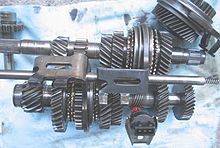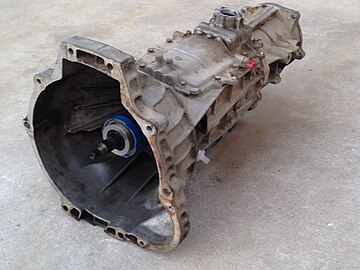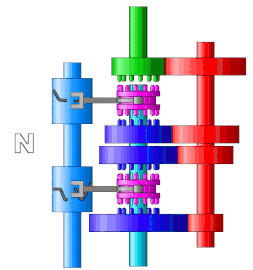Transmission (mechanical device)

Atransmission(also called agearbox) is a mechanical device which uses agear set—two or moregearsworking together—to change the speed, direction of rotation, or torque multiplication/reduction in amachine.[1][2]
Transmissions can have a single fixed-gear ratio, multiple distinctgear ratios,or continuously variable ratios. Variable-ratio transmissions are used in all sorts of machinery, especially vehicles.
Applications
[edit]Early uses
[edit]Early transmissions included the right-angle drives and other gearing inwindmills,horse-powered devices, andsteam-powered devices. Applications of these devices includedpumps,millsandhoists.[citation needed]
Bicycles
[edit]Bicyclestraditionally have usedhub gearorDerailleur geartransmissions, but there are other more recent design innovations.
Automobiles
[edit]
Since thetorqueandpoweroutput of aninternal combustion enginevaries with itsrpm,automobilespowered by ICEs require multiple gear ratios to keep the engine within itspower bandto produce optimal power,fuel efficiency,and smooth operation. Multiple gear ratios are also needed to provide sufficient acceleration and velocity for safe & reliable operation at modern highway speeds. ICEs typically operate over a range of approximately 600–7000 rpm, while the vehicle's speeds requires the wheels torotatein the range of 0–1800 rpm.[3]
In the early mass-produced automobiles, the standard transmission design wasmanual:the combination of gears was selected by the driver through a lever (thegear stick) that displaced gears and gear groups along their axes. Starting in 1939, cars using various types ofautomatic transmissionbecame available in the US market. These vehicles used the engine's own power to change the effective gear ratio depending on the load so as to keep the engine running close to its optimal rotation speed. Automatic transmissions now are used in more than 2/3 of cars globally, and on almost all new cars in the US.
Most currently-produced passenger cars with gasoline or diesel engines use transmissions with 4–10 forward gear ratios (also called speeds) and one reverse gear ratio.Electric vehiclestypically use a fixed-gear or two-speed transmission with no reverse gear ratio.

Motorcycles
[edit]Fixed-ratio
[edit]The simplest transmissions used a fixed ratio to provide either a gear reduction or increase in speed, sometimes in conjunction with a change in the orientation of the output shaft. Examples of such transmissions are used inhelicoptersandwind turbines.In the case of a wind turbine, the first stage of the gearbox is usually a planetary gear, to minimize the size while withstanding the high torque inputs from the turbine.[4][5]
Multi-ratio
[edit]Many transmissions – especially for transportation applications – have multiple gears that are used to change the ratio of input speed (e.g. engine rpm) to the output speed (e.g. the speed of a car) as required for a given situation. Gear (ratio) selection can be manual, semi-automatic, or automatic.
Manual
[edit]A manual transmission requires the driver to manually select the gears[6]by operating agear stickandclutch(which is usually a foot pedal for cars or a hand lever for motorcycles).
Most transmissions in modern cars usesynchromeshto synchronise the speeds of the input and output shafts. However, prior to the 1950s, most cars usednon-synchronous transmissions.
-
16-speed tractor transmission (plus 8 reverse gears)
-
Mazda M5ODmanualtransmission (viewed from the engine side)
-
Animation of a 4-speedsequential manual transmission
Sequential manual
[edit]A sequential manual transmission is a type of non-synchronous transmission used mostly for motorcycles and racing cars. It produces faster shift times than synchronized manual transmissions, through the use ofdog clutchesrather than synchromesh.[7]Sequential manual transmissions also restrict the driver to selecting either the next or previous gear, in a successive order.
Semi-automatic
[edit]Asemi-automatic transmissionis where some of the operation is automated (often the actuation of the clutch), but the driver's input is required to move off from a standstill or to change gears.
Automated manual / clutchless manual
[edit]An automated manual transmission (AMT) is essentially a conventional manual transmission that uses automatic actuation to operate the clutch and/or shift between gears.
Many early versions of these transmissions were semi-automatic in operation, such asAutostick,which automatically control only theclutch,but still require the driver's input to initiate gear changes. Some of these systems are also referred to asclutchless manualsystems.[8]Modern versions of these systems that are fully automatic in operation, such asSelespeedandEasytronic,can control both the clutch operation and the gear shifts automatically, without any input from the driver.[9][10]
Automatic
[edit]Anautomatic transmissiondoes not require any input from the driver to change forward gears under normal driving conditions.
Hydraulic automatic
[edit]The most common design of automatic transmissions is the hydraulic automatic, which typically usesplanetary gearsetsthat are operated usinghydraulics.[11][12]The transmission is connected to the engine via atorque converter(or afluid couplingprior to the 1960s), instead of thefriction clutchused by most manual transmissions and dual-clutch transmissions.[13]
-
Hydraulic automatictransmission (cutaway view)
-
Epicyclic gearingdiagram, as used in hydraulic automatic transmissions
-
Cutaway view of aZF 6HPhydraulic automatic transmission
Dual-clutch (DCT)
[edit]A dual-clutch transmission (DCT) uses two separateclutchesfor odd and evengear sets.[14]The design is often similar to two separatemanual transmissionswith their respective clutches contained within one housing, and working as one unit.[15][16]In car and truck applications, the DCT functions as an automatic transmission, requiring no driver input to change gears.
Continuously-variable Ratio
[edit]A continuously variable transmission (CVT) can change seamlessly through a continuous range ofgear ratios.This contrasts with other transmissions that provide a limited number of gear ratios in fixed steps. The flexibility of a CVT with suitable control may allow the engine to operate at a constantRPMwhile the vehicle moves at varying speeds.
CVTs are used in cars, tractors,side-by-sides,motor scooters,snowmobiles,bicycles, andearthmoving equipment.
The most common type of CVT uses twopulleysconnected by abeltorchain;however, several other designs have also been used at times.
Noise and vibration
[edit]Gearboxes are often a major source ofnoisenoise and vibration in vehicles and stationary machinery. Highersound levelsare generally emitted when the vehicle is engaged in lower gears. The design life of the lower ratio gears is shorter, so cheaper gears may be used, which tend to generate more noise due to smaller overlap ratio and a lower mesh stiffness etc. than the helical gears used for the high ratios. This fact has been used to analyze vehicle-generated sound since the late 1960s, and has been incorporated into the simulation of urban roadway noise and corresponding design of urbannoise barriersalong roadways.[17]
See also
[edit]References
[edit]- ^J. J. Uicker; G. R. Pennock; J. E. Shigley (2003).Theory of Machines and Mechanisms(3rd ed.). New York: Oxford University Press.ISBN9780195155983.
- ^B. Paul (1979).Kinematics and Dynamics of Planar Machinery.Prentice Hall.
- ^Naunheimer, Harald; Bertsche, Bernd; Ryborz, Joachim; Novak, Wolfgang (2011). "Power Conversion: Selecting the Ratios".Automotive Transmissions: Fundamentals, Selection, Design and Application.Springer. pp. 100–114.doi:10.1007/978-3-642-16214-5_4.ISBN978-3-642-16214-5.Retrieved21 January2023.
- ^Stiesdal, Henrik (August 1999),The wind turbine: Components and operation(PDF),retrieved2009-10-06
- ^Musial, W.; Butterfield, S.; McNiff, B. (May 2007),Improving Wind TurbineGearbox Reliability(PDF),National Renewable Energy Laboratory, archived fromthe original(PDF)on September 23, 2012,retrievedJuly 2,2013
- ^"Manual Transmission Operation".YouTube.Retrieved21 January2023.
- ^"How Sequential Gearboxes Work".www.howstuffworks.com.4 April 2003.Retrieved2 January2020.
- ^"Hyundai Created a Clutch-less Manual Transmission".10 July 2020.
- ^"Directly from the Formula 1".www.magnetimarelli.com.Retrieved26 July2020.
- ^"Introduction to Automatic Transmission Systems".www.tranzmile.com.Retrieved1 August2020.
- ^"How Automatic Transmissions Work".www.howstuffworks.com.29 November 2000.Retrieved22 November2020.
- ^"What Makes Automatic Transmissions Automatic".Popular Mechanics.Hearst Magazines: 169–173. February 1955.Retrieved22 November2020.
- ^"How does the AT work?".AW North Carolina.Archived fromthe originalon 6 October 2014.Retrieved6 October2014.
- ^"Powertrain — transmissions: Shift in power to the gearbox"(PDF).AMS.UnofficialBMW.com. September–October 2003.Archived(PDF)from the original on 17 July 2011.Retrieved31 October2009.
- ^"Automatic-shifting dual-clutch transmissions are poised to grab share from traditional transmissions thanks to their combination of efficiency and convenience"(PDF).AEI-online.org.DCTfacts.com. June 2009. Archived fromthe original(PDF)on 7 October 2011.Retrieved31 October2009.
- ^"Porsche Doppelkupplung (PDK)".Porsche.com. Archived fromthe originalon 5 December 2008.Retrieved31 October2009.
- ^Hogan, C. Michael; Latshaw, Gary L. (21–23 May 1973).The Relationship Between Highway Planning and Urban Noise.Proceedings of the ASCE, Urban Transportation Division Specialty Conference. Chicago, Illinois: American Society of Civil Engineers, Urban Transportation Division. Archived fromthe originalon 18 May 2007.Retrieved12 September2007.






